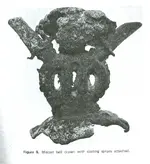Seasons greetings,
It is sometimes hard to tell when someone is joking.

If Cactusjumper is simply pulling our leg, it is a good one.

Mrs O and I are somewhat handicapped for "source" books, as the majority of our little library is not accessible. So I have been making use of the not-inconsiderable materials available online, which I am sure some folks take offence to as "worthless and unreliable" but as our discussion is not simply for the sake of the opinions of us whom are actively posting, I think they are worth including. Our readers are free to accept or dismiss any or all of what we post.
*
Side note, we did pull out one box of books, which turns out to be nearly all on the Black Hills. Not helpful for our discussion but sure looking forward to next summer! 
*
Father Kino's writings on Pimeria are online at
http://books.google.com/books?id=EwF6AAAAMAAJ&pg=PA5#v=onepage&q=&f=false
...and on checking, this places the mission named as one day's journey from his mission at Dolores, which is curious. There are some rather interesting passages too, such as a number of minor (visita) missions which Kino established, and are not mentioned by later historians such as Bancroft <who makes a number of errors, tending to minimize the explorations and works of Kino> but as these missions are mentioned by Father Visitor Salviaterra a couple of years later, it seems safe to conclude that there were considerably more missions in southern Arizona than many historians will grant. What is missing entirely are records of Jesuit (or Franciscan) attempts to convert and reduce the Apaches. Are we to presume that NO attempts were ever made? We know that at least some Apaches came in to Tucson and became "Mission Indians" so the possibility was there, not all Apaches were utterly hostile.
I had a bit more to add concerning the expulsion of the Jesuits - for example when they were expelled from Japan in the early 1600's, out of 122 Jesuits, 46 remained behind, by the ruse of having European sailors dress in their robes for the 'roundup'. After being caught and shipped out, many (nearly all) soon returned by sneaking back into Japan. This may not be directly related to what happened in the New World over 100 years later, but shows that it was possible for the Jesuits to avoid being expelled and some could sneak back. Do we know for a fact, that every one of the padres arrested in 1767, was the padre and not an imposter?
Father Kino's memoirs on Pimeria includes letters from Father Saeta. They certainly seem innocent enough, but we find a couple of passages which could be interpreted differently. For example, Father Saeta, after being assigned to his new church, found that he was very busy with his labors, both spiritual and "temporal" - and here temporal would cover everything and anything from doing laundry to branding cattle, or supervising mines. Another passage,
discuss many things I shall be glad if the articles of clothing referred to can be brought at the time of meeting from some of these mining towns for my children for they are limited to sackcloth blankets tunics and pisiete I will promptly pay what they are worth either in wheat or in silver at the latest at wheat harvest for here work proceeds with vigor feruet opus B
<
http://books.google.com/books?id=EwF6AAAAMAAJ&pg=PA138#v=onepage&q=silver&f=false>
...mentions that he will be able to pay for the clothing and articles (for the mission children) in wheat or SILVER. The Silver may have been from alms collected, or from the sale of mission produce, or his own pocket, or from silver mines being worked by mission Indians under supervision of the Jesuits. We can't say for certain, but it is notable that he said "silver" and not "in coin" or "in money" or cash, pesos, etc. It appears that he meant just what he wrote - silver. It is also something to consider that Father Saeta was newly posted to the church, and was responsible for Tubutama; that Father Kino describes him as "very zealous" and in his own letter he says work proceeds with vigor. Again this could be utterly innocent, or it could show us that he was a bit harsh (out of religious zeal) and his Opata overseers were beating the Pimas severely, which I propose are likely roots of the whole 1695 Pima revolt.
Joe - I don't need to see a photo of gold bars to believe, if you would rather not post such pix I have no problem. Do you know of any record, from that time period, which will support the scenario you have presented? Dark or ugly parts of history do get expunged by historians, so I don't expect to see a lot - however when such erasures are done, often a small hint will escape notice by the "editors" whom are censoring the records.
Lamar are you serious, that a silver bell cannot be rung because it will crack? Are you willing to place your reputation behind that idea?
Wishing you all a very Merry Christmas,
Oroblanco

















 *
*

